Processing Signals in Draft, Step by Step
12/08/2023
Signals are one of the hardest parts of draft. Trying to figure out what the other drafters in your pod are drafting just from the leftover cards in the packs they pass you is a daunting task, and yet there actually is quite a lot of information to be gleaned. But it's also dangerous to go too far, and read too much into signals when there is only noise. So how do you strike this balance?
Part 1: The Basics
To talk about signals, we must first define them. So, what is a signal?
Definition
In draft, a signal is any piece of information that lets you infer what the other drafters in your pod are doing and predict what this will mean for the rest of the draft.
This is a very broad definition; it kind of has to be, as there are quite a few kinds of signals you can experience. But all signals boil down to this process: parse the information you get from seeing a pack, use that information to make an inference, and use that inference to make predictions.
An example of how this process might work: in day 2 draft 2 of the WOE 100k Limited event in Vegas, I opened up an interesting P1P2. I noted the information I got from this pack: an uncommon was missing, with
Song of Totentanz still in the pack as the rare. I used that information to make an inference: there aren't many uncommons I would expect someone to take over that rare, so I suspected that Imodane's Recruiter was taken. And finally, I used that inference to make a prediction: red and white would likely be less open from that direction, so I should be careful about going into those colors.Part 2: Information
So let's start with the first part of this process: the information. What is the information you get out of looking at a pack in a draft? Well, there's really only one direct source of information: the cards in the pack. But there are a couple ways to also figure out which cards aren't in the pack.
Follow the Pack Collation
Early in the pack, before the wheel, the most useful tool for figuring out which cards have been taken is pack collation.
In case you don't know what that means, briefly: pack collation is a rough pattern that all packs follow. For example, almost every pack has exactly one rare, exactly three uncommons, and exactly ten commons (until Play Boosters - we'll get to those). And in addition to that, on Arena there is a guarantee that every pack will have one common of each color.
But there are also slight variations to be aware of - for example, in paper, foils occur in some fraction of packs and can be any rarity, and replace a common when they do appear (so this would make it 1 rare/mythic, 3 uncommons, 9 commons, and 1 foil).
Some sets (actually, quite a few sets these days) will also have special collations. WOE had a special "enchanting tales" bonus sheet slot - guaranteed one in every pack in place of one of the commons. LCI has a dedicated common/uncommon double-faced card slot, and a basic land slot that can sometimes contain a cave. Here's some visualizations:
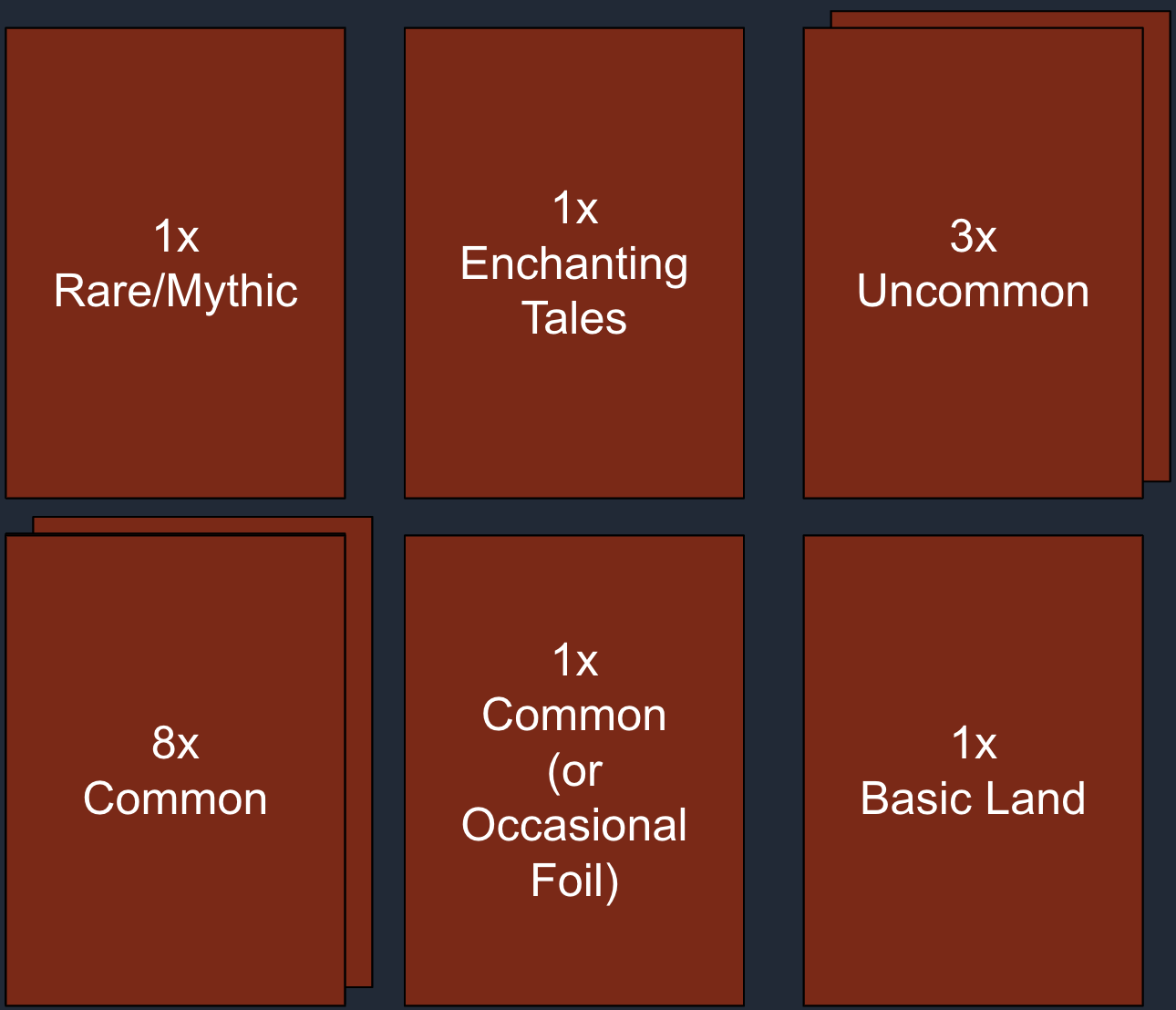
WOE pack collation
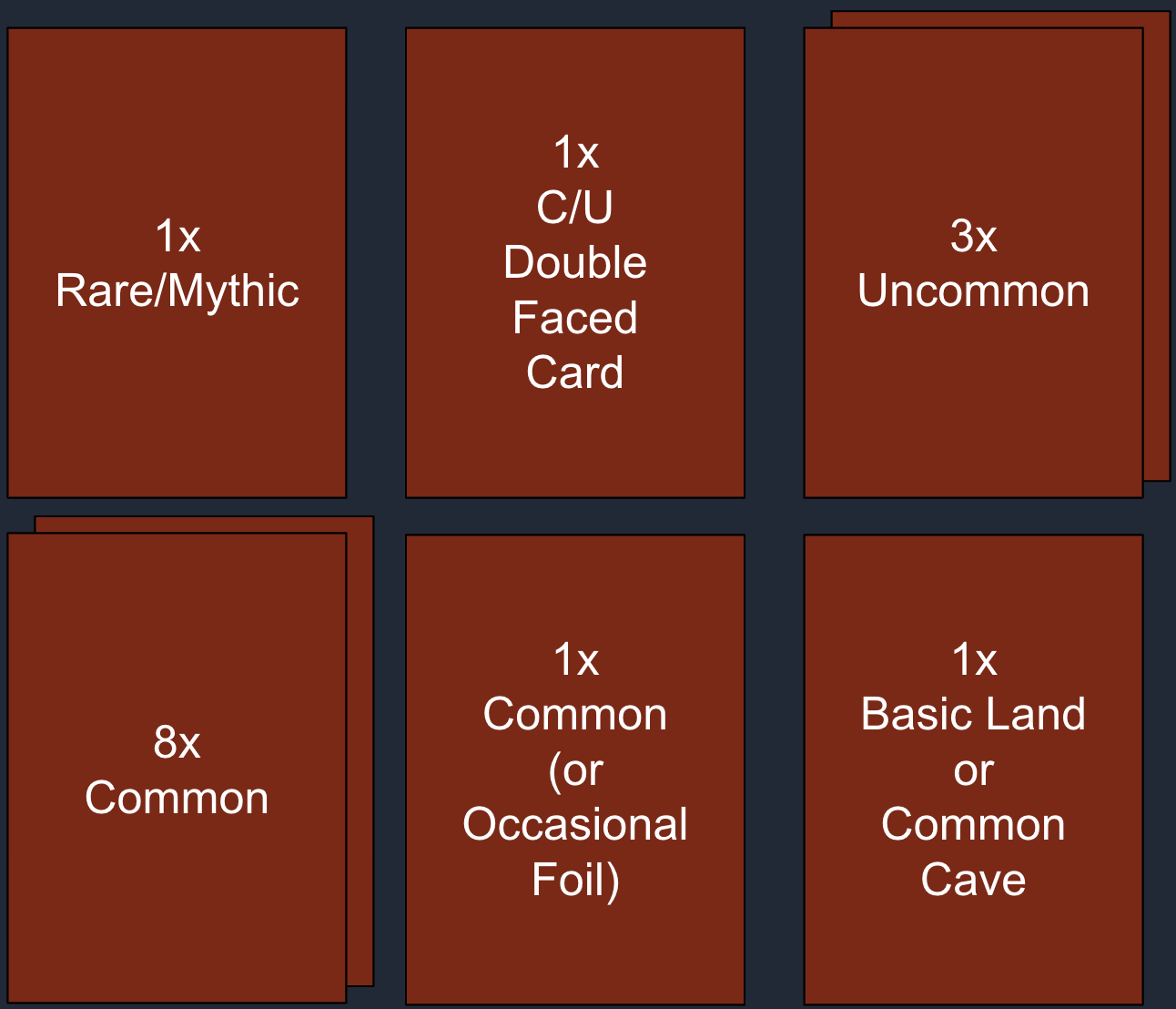
LCI pack collation
Knowing how these pack collations work is very important for parsing signals - you can often use these patterns, along with the pattern of one color of each common guaranteed, to deduce what kinds of cards are missing from a pack! A few examples:
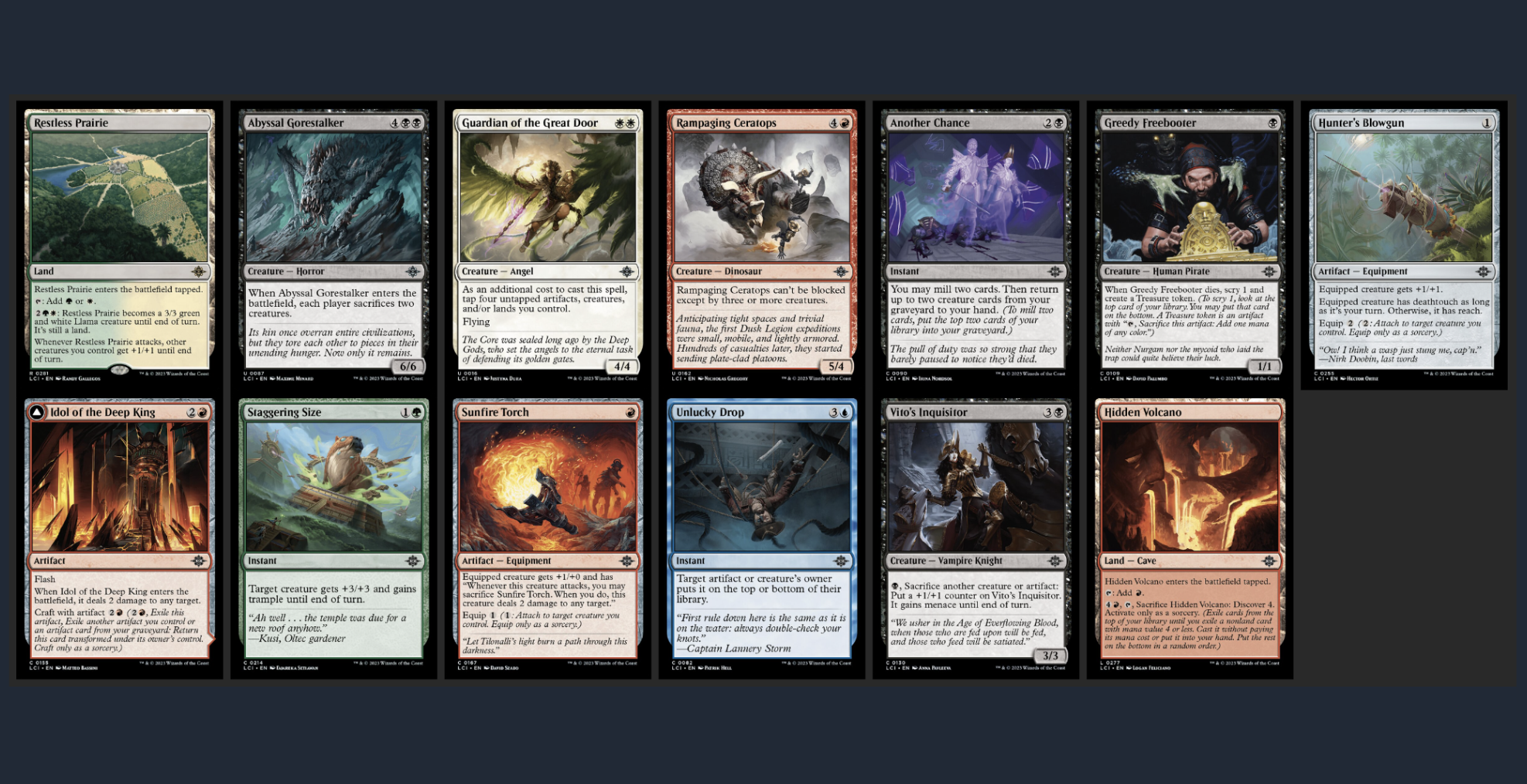
In this pack, we can count one rare, three uncommons, and a DFC. In addition, none of the commons present are white. So, there must be two missing commons, and at least one of them must be white.
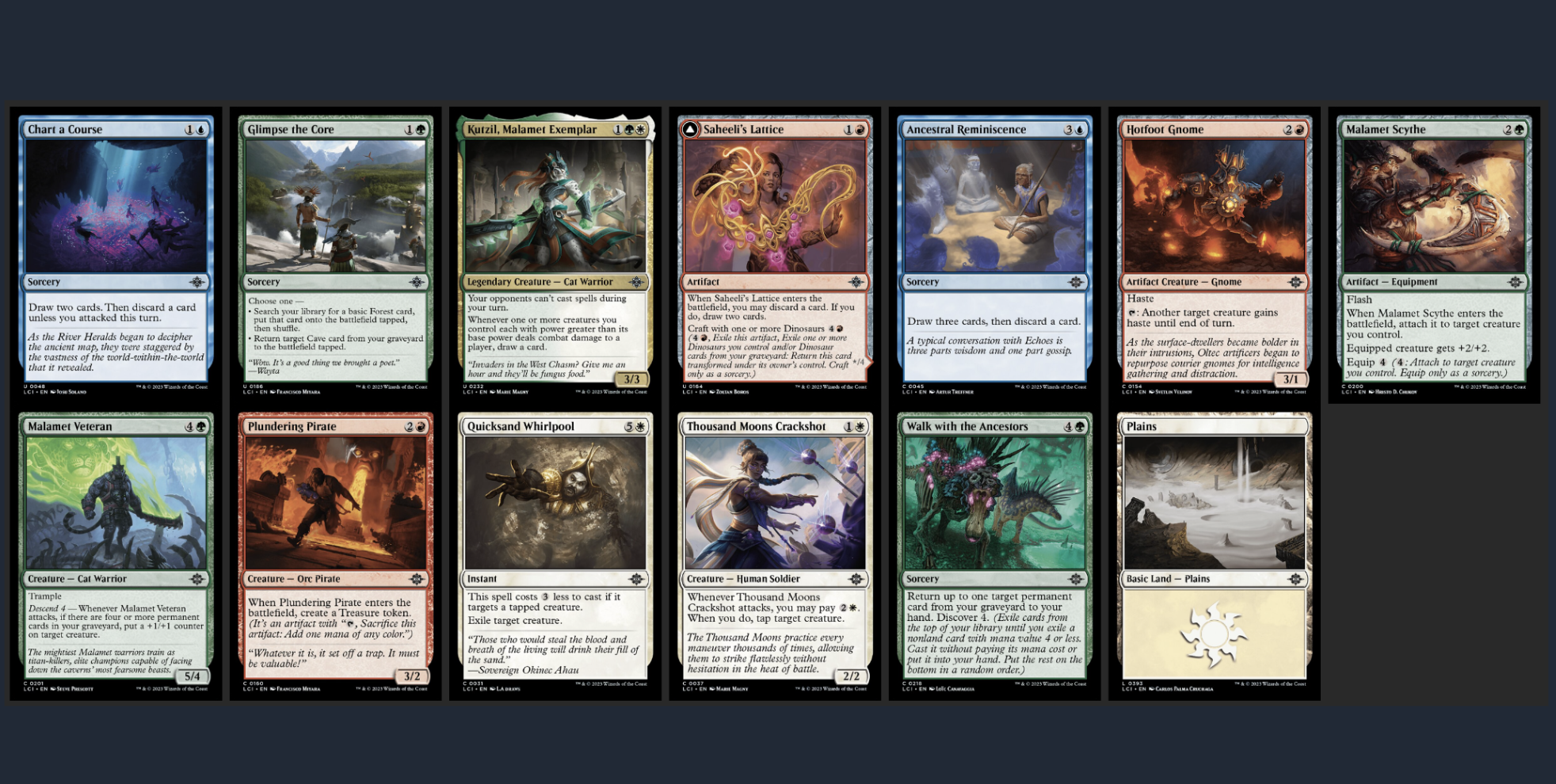
In this pack, we can count three uncommons, a DFC, and eight commons. So, the missing cards must be a rare/mythic and a common
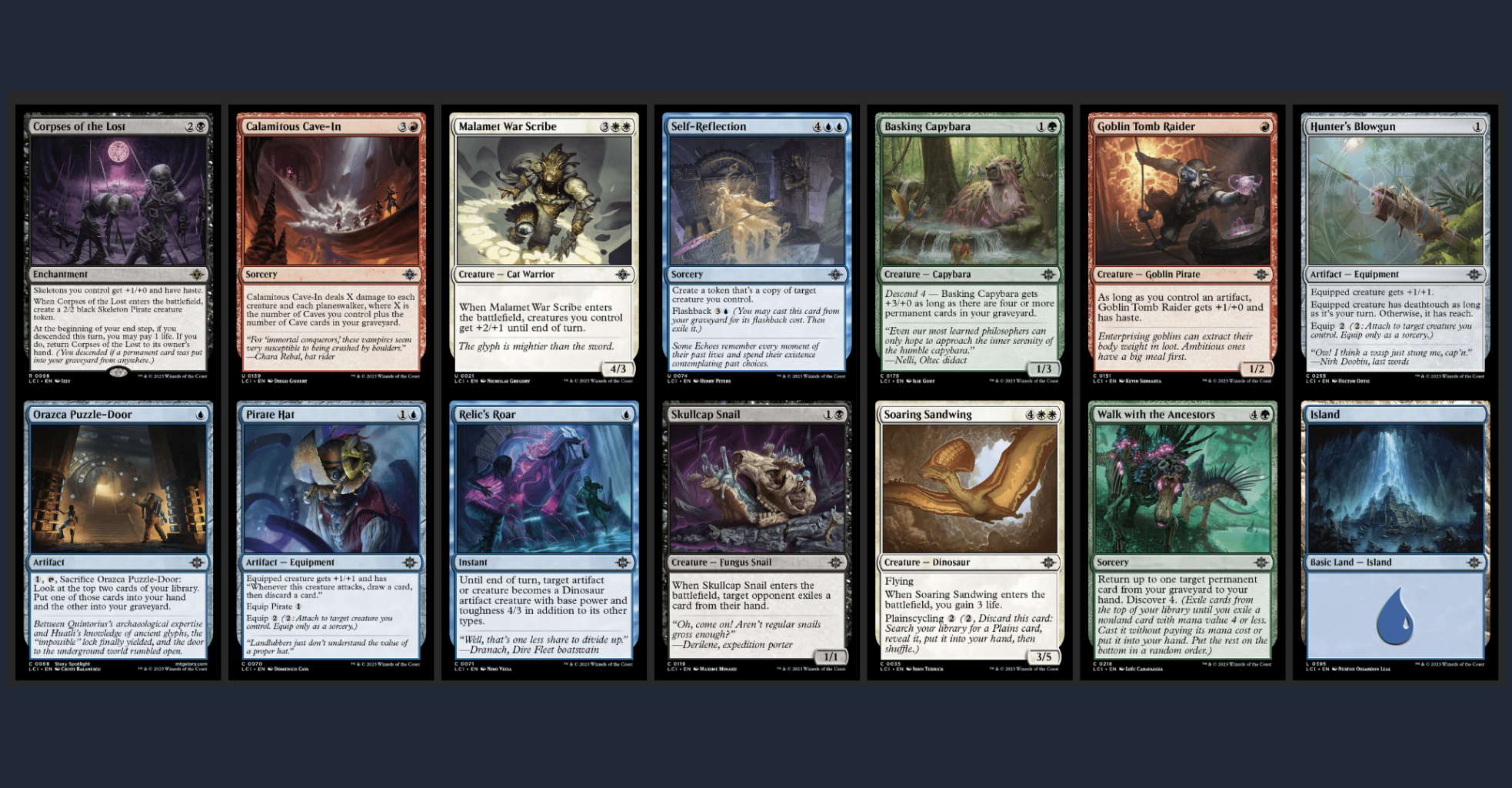
In this pack, we can count one rare, three uncommons, and nine commons. So, the missing card must be a common or uncommon DFC.
Sidenote: Play Boosters
Starting with the next set, MKM, there will be a new type of booster for draft, with a new kind of collation. This kind of collation looks to have a bit more variance than previous packs; similar to how current packs sometimes have a foil that can be anything, play boosters will have basically three different slots that could sometimes be anything. This will make reading information from pack collation harder, but it will still certainly be useful.
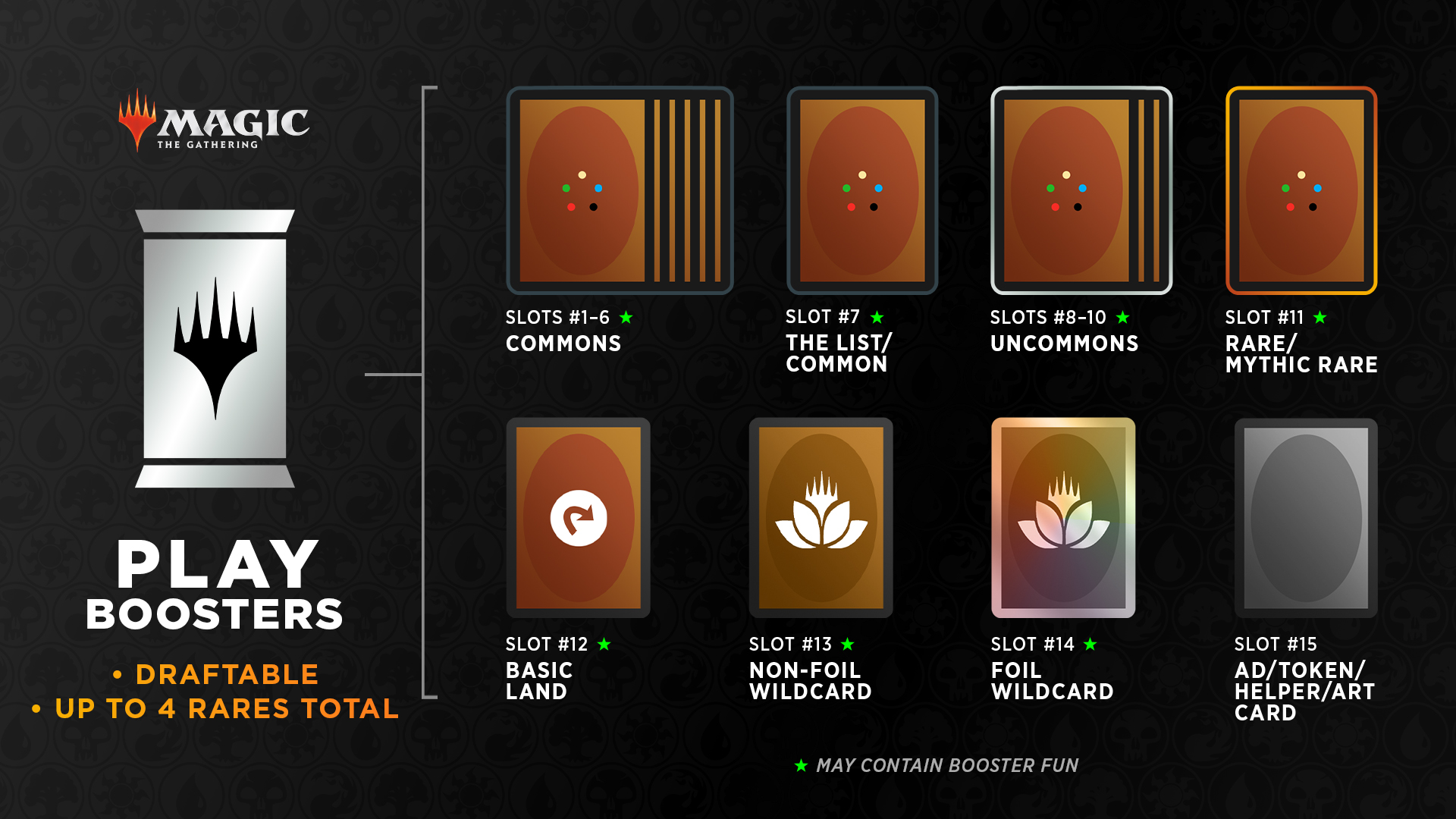
Play Booster collation
Sidenote: Advanced Pack Collation
Pack collation technically goes further than just these basic patterns - sometimes you can predict with perfect precision which card is missing from a pack. One of the most infamous examples of this is RNA, where
Dovin's Acuity and High Alert almost always appeared in the same pack together, and any pack with two Lockets in it must also have had a Frenzied Arynx.Since then, print runs have gotten more complex and harder to read specific details from, but it's still technically possible. In fact, I've done this on Arena by analyzing 17lands draft data (here's three tweet threads about my work on this) - it's not something you could easily memorize like "two Lockets imply an Arynx, Dovin's Acuity is next to High Alert", but you could theoretically run a script that fetches the proper data, and which can often tell you which exact four commons are missing from a pack.
Don't Forget the Wheel
Of course, there is a way to figure out exactly what's missing from a pack, but it only becomes available later into the pack: the wheel.
You can get a lot of information out of the wheel if you pay attention - every pack from P1P9 onwards tells you exactly which cards the rest of your pod picked since you last saw the pack! Of course, you have to remember which cards you saw previously in that pack, which isn't always easy.
Online, you can make use of a tracking tool to help with this - if you're running 17lands, for example, opening the draft log in a browser window will update the missing cards for you pretty quickly.
But of course, some would argue that this is a crutch - and in paper, you're on your own. So if, like me, you don't have that good of a memory, I would highly recommend focusing on one or two key cards in each pack - you don't need to know if a mediocre filler common was taken. Even the conscious effort of just paying attention to whether the okay common in your colors wheels can really help with your awareness of the draft.
Part 3: Inferring and Predicting
Once you've gotten some idea what cards are missing from the pack, the next step is to use that information to infer what the other drafters in your pod are doing, and use that to predict what you'll see in the future.
When you're making these judgements, it's important to keep in mind that they're inherently extremely fuzzy and error-prone. As with many things in Magic, there is a lot of variance and uncertainty involved; even moreso here where you're trying to infer what other drafters at your table are thinking. So you should always be cautious in acting on your predictions - many things can go wrong, from other players not matching your expectations, to weird packs causing unlikely chains of events to happen.
And the first example I gave at the start of this article (the one at the WOE 100k) is even a great example of this! It turns out that the drafter to my right took
Gingerbread Hunter, not Imodane's Recruiter, and drafted green black the whole time, instead of being in red or white like I thought he was. But the drafter to his right was coincidentally drafting close to mono-red, so while my initial inference was wrong, the prediction I came up with lined up with the further signals I got throughout pack 1, and ended up getting solidified.It's worth noting that how you read signals should also depend heavily on who you're drafting with! Arena drafters will behave a lot differently from Pro Tour drafters, and you should tune your expectations to match who you're drafting with. In drafts at your local game store, you can even fine tune your signal reading to match up with the specific people you draft with - for example, I used to draft at an LGS with a player who forced green something like 75% of drafts.
Range, Strength, and Specificity
I would highly recommend watching Sierkovitz's Magic Numbers seminar on signals. The things he focuses on in that seminar are somewhat different than what I'm focusing on here - he goes in-depth about analyzing individual cards as signals through data analysis, whereas in this article I'm focusing on the general process of interpreting signals - but he does bring up an extremely important topic in which we overlap: paying attention to the range, strength, and specificity of signals.
Range describes what set of drafters the signal points to; this generally completely depends on simply which pack it is. A signal in P1P3 points to only the two drafters before you; a signal after the wheel on P1P9 points to the entire table.

An example of the range of a signal
Strength describes, well, how strong the signal is. How strongly do you believe in your prediction? Seeing that a strong rare is still in the pack is generally a very strong signal, as you would naturally expect it to be gone, so it's very likely that something weird happened; on the flip side, seeing an okay common in the pack, even if it is a bit later than you might expect, is probably quite a weak signal.
Specificity describes how specific your inferences and predictions are. "I think the drafter to my right took exactly Imodane's Recruiter" is very specific; "I think blue is generally being cut in this pod" is not that specific. It's important not to confuse a signal for being more specific than it actually is. Seeing blue being cut in P1P5 doesn't mean the player passing to you specifically is in blue; it could just mean players almost across the table from you are in blue, which would mean a completely different thing.
Once is Coincidence, Twice is Enemy Action
One simple way to avoid reading too much into signals and being led astray is to just be more hesitant to make concrete conclusions until you see repeated signals. One signal can be just the result of a weird pack or a weird drafter, but several signals all pointing in the same direction is a lot stronger evidence that something is going on.
Of course, there are some very strong, very specific signals that you can probably take to be accurate even by themselves - but even still things can go wrong with other drafters just simply behaving outside our expectations, just look at the Recruiter example! Even in that case, where it seemed fairly cut and dry, I took some caution and didn't fully believe the signal as truth until I saw that future picks also inditicated the same thing: that red was cut.
Missing colors
The simplest kind of inference is just looking at missing colors - if you see that one color of common is missing, then you know that someone must have taken that, and can infer that they're probably in that color and predict that they will continue taking cards of that color in the future. So you can mentally note to expect to see less of that color in the future, and perhaps bias away from it.

We identified above that this pack is missing a two commons, at least one of which is white. So we can probably guess that someone took a white common, and use that to bias a bit away from taking the Guardian of the Great Door. It can still be reasonable to take it, for example if we're already white, but it would be with the knowledge that white is more likely to get cut than usual.
Missing cards
You can also look at missing cards, and compare them to cards that are still in the pack; the Recruiter example above is an instance of this. If you see a common missing with good uncommons or even a rare still in the pack, you can figure that it was probably a pretty good common. You could try to guess what that common is - some sets have a common that's by far the best common in the set, like
Preening Champion or Inspiring Overseer, and in those sets an unexpected missing common is likely to be one of those. You could even try to just guess the color - if there's a strong red rare in a pack, it's a lot more likely someone took a strong non-red common than a strong red common, as maybe the reason they passed on the rare was for color reasons.Late cards
Another way to look at a similar kind of signal is by noting that a card has gone later than you would've expected. It might just be that other drafters are valuing it less than you are, or that the card was in an unusually strong pack, but you can also take it as slight evidence that the color of that card is open, as one of the biggest reasons someone might not take a strong card is because they can't cast it.

We identified above that this pack is missing a common/uncommon double-faced card. In addition, Corpses of the Lost, a strong black rare, is still in the pack. So, we can infer that the player to our right either doesn't want to draft black, or took a very strong DFC (like Clay-Fired Bricks), or both. And so we can probably predict that black will be more open than usual.
General color volume
Finally, probably the most commonly brought up kind of signal is one of the most vague, in the form of statements like "I think blue is being cut" or "I think red is open". This kind of signal is really hard to talk about, because it's just really hard in general to say what exactly indicates a color being "open" or "cut".
The best advice I can offer is threefold:
First, you should mostly ignore mediocre cards for this purpose. If a card is unlikely to make it into your deck, it's unlikely that seeing it late means much at all. Even seeing a bunch of mediocre cards of the same color doesn't really mean anything - people are not obligated to take a card just because it's in their colors, and are in fact pretty likely to take a better card of their other colors.
Second, this is probably the most relevant scenario for my above advice: just a single instance of a vague color signal like this is not worth acting on much. If a color is truly open, or truly cut, you will see signs of this many times, and can act on it then.
And finally, don't make bad picks just because you think a color might be "open". If you already have a good thing going on in a different color, and can keep just taking good cards for that plan, there's often not really a reason to diverge and speculate. It's a lot easier to trainwreck from tricking yourself into following a signal too much, than it is to lose much from not capitalizing enough from a signal.
Piecing it Together
In this article, I've broken down the process of reading and interpreting signals into very small piecesIt would be nice if I could boil it down even further to an exact science - but in reality, everything from parsing the information from a pack to using it to make predictions about the rest of the draft should ideally happen quickly and instinctually.
The problem is that these instincts can be pretty hard to hone. So, if you aren't at that level yet, I would highly recommend taking a step back, slowing down, and very intentionally walking through the process.
Maybe try going through a draft and writing down all of your predictions, and then seeing how many of them actually pan out. You can even do this just by looking at someone else's draft log, or an old one of yours that you've forgotten the details of.
Practice makes perfect, and deliberate practice even more so - but keep in mind that, in the end, it's really hard to say what "perfect" is in the art of signal processing. There will always be more variables than we can reasonably consider, and enough variance that there's never a strictly "correct" answer.
But even with signals being so inherently fuzzy and hard to grasp, it's still important to try! There's a lot of edge to gain from predicting what your pod is doing, and any edge you can get can count for a lot in a game like Magic.
#FreePalestine | Consider donating to UNWRA or PCRF, supporting protesters locally, and educating yourself.
